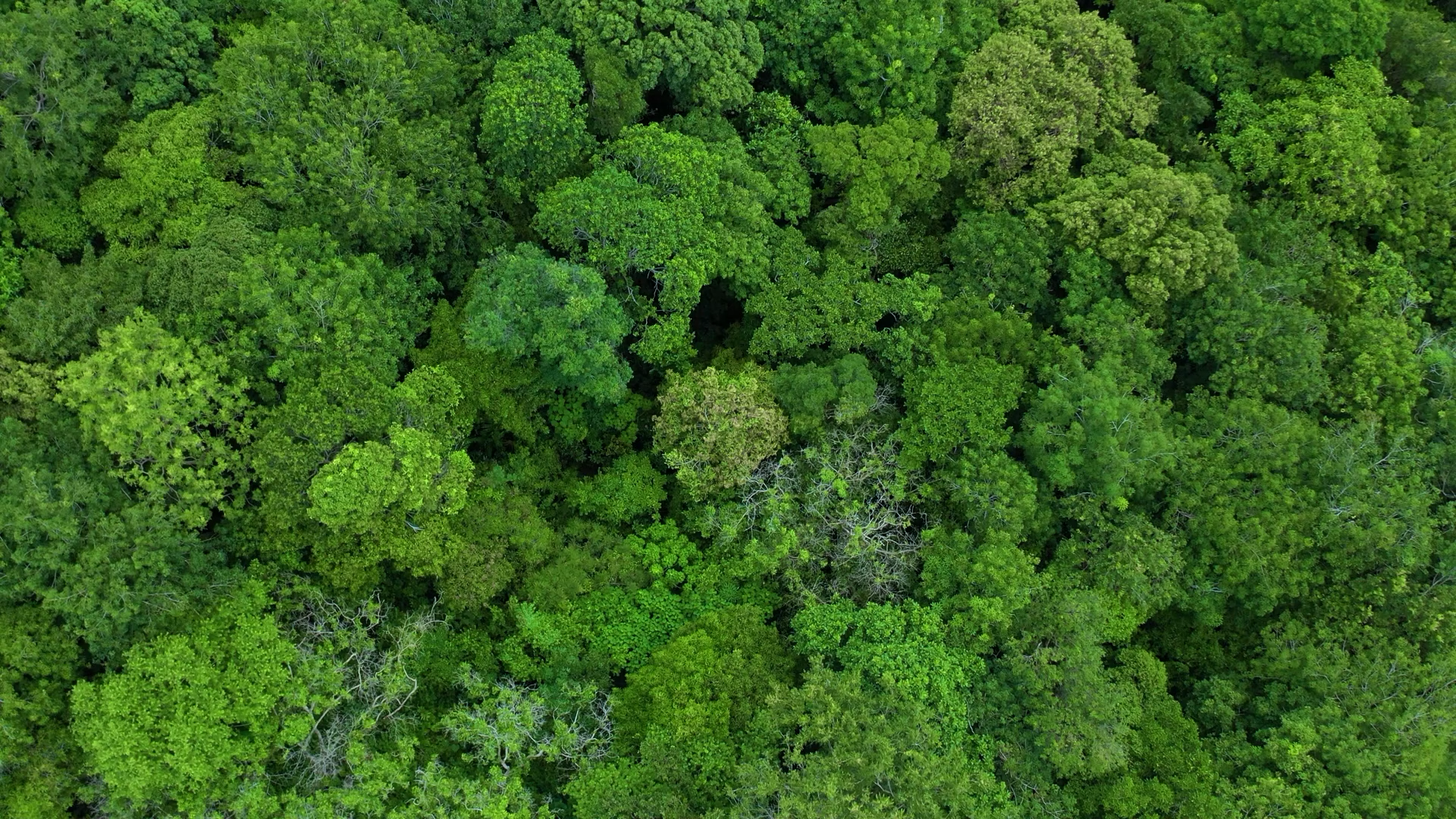The Mind of Plants
Narratives of Vegetal Intelligence
Synergetic PressBook launchWebsite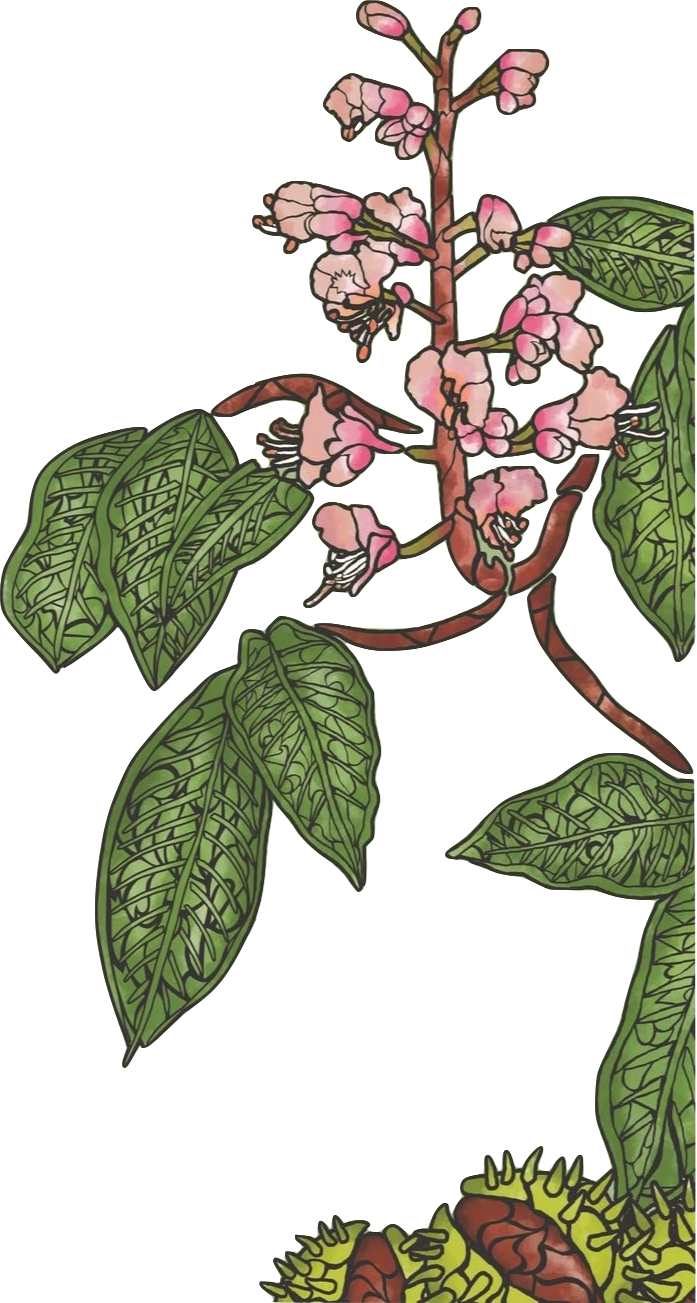
Welcome to this, the Spring 2023 special issue of TEA magazine. In this special issue, titled ‘The Mind of Plants’, we present a collection of ruminations on the notion of plant mindedness (cf. Gagliano 2017) and thinking (cf. Marder 2013)—not just thinking about plants, but equally, and also, thinking with and thinking like plants.* The special issue is a celebration of the recent land-mark edited volume of the same name: The Mind of Plants: Narratives of Vegetal Intelligence (Synergetic Press, 2021)—edited by Monica Gagliano, Patrícia Vieira, and John C. Ryan. The diverse and inspiring contributions to this issue—like the book—collectively explore how humans live, coexist, and think with plants, but also how plants themselves may "think" or "know" (entailing notions of vegetal cognition, intelligence, and sentience).
The issue includes an in-depth interview with plant scientist and philosopher Monica Gagliano (featured as a multimedia article and audio podcast); several excerpts from the book (chapters by Robin Wall Kimmerer on white pine and Esthela Calderón on corn, as well as poetry by Craig Santos Perez on wild piper); as well as two "Plant Conversations"—podcasts with prominent "plant thinkers" including Jeremy Narby and Sarah Laborde (in conversation one) and Luis Eduardo Luna and Kristi Onzik (in conversation two) discussing the plants they have written about in the book (cannabis, apple, ayahuasca, and passionflower respectively). Thinking through these plants—all chosen for their personal and sometimes spiritual resonance—allows the interlocutors to explore deeper notions of plant consciousness and embodiment, as well as science, religion, dreams, and animism.
We are also pleased to present several exciting articles outside of the special issue, including Irene Teixidor-Toneu et al. on the ethnobotany of the Amazonian ivory-palm button; Steffan Gwynn's exhibition review of Levon Biss's spell-binding macro photography of seeds and fruit; and a pair of plant-inspired poems about the American south by Carson Colenbaugh.
We hope you enjoy joining us in this vibrant celebration of plant mindedness, featuring a plurality of voices (human and plant) exploring plant-people alliances through diverse and often experimental narrative forms and genres. Plants, as the contributors explore, offer endless possibilities for thought.
Lewis Daly and Kay-Lewis Jones,
Co-editors, TEA
* Over the past decade, themes of plant intelligence, thinking, knowing, cognition, and neurobiology have been explored by scholars working across the natural and social sciences and the humanities, including Trewavas (2002), Mancuso (2006), Chamovitz (2012), Marder (2013), Kimmerer (2013), Gagliano (2013, 2017), and Calvo et al. (2020).
Here are some useful references on the theme, for interested readers:
- Calvo, Paco, Monica Gagliano, Gustavo M. Souza, and Anthony Trewavas (2020) Plants are intelligent, here's how. Annals of Botany 125(1): 11-28.
- Chamovitz, Daniel (2012) What a Plant Knows: A Field Guide to the Senses. London: Oneworld Publications.
- Gagliano, Monica (2013) Seeing green: The re-discovery of plants and Nature's wisdom. Societies 3(1): 147-157.
- Gagliano, Monica (2017) The mind of plants: Thinking the unthinkable. Communicative and Integrated Biology 10(2): e1288333.
- Kimmerer, Robin Wall (2013) Braiding Sweetgrass: Indigenous Wisdom, Scientific Knowledge, and the Teachings of Plants. New York: Penguin.
- Mancuso, Stephano (2006) Plant neurobiology: An integrated view of plant signaling. Trends in Plant Science 11(8): 413-419.
- Marder, Michael (2013) Plant-Thinking: A Philosophy of Vegetal Life. New York: Columbia University Press.
- Trewavas, Anthony (2002) Plant intelligence: Mindless mastery. Nature 415: 841.
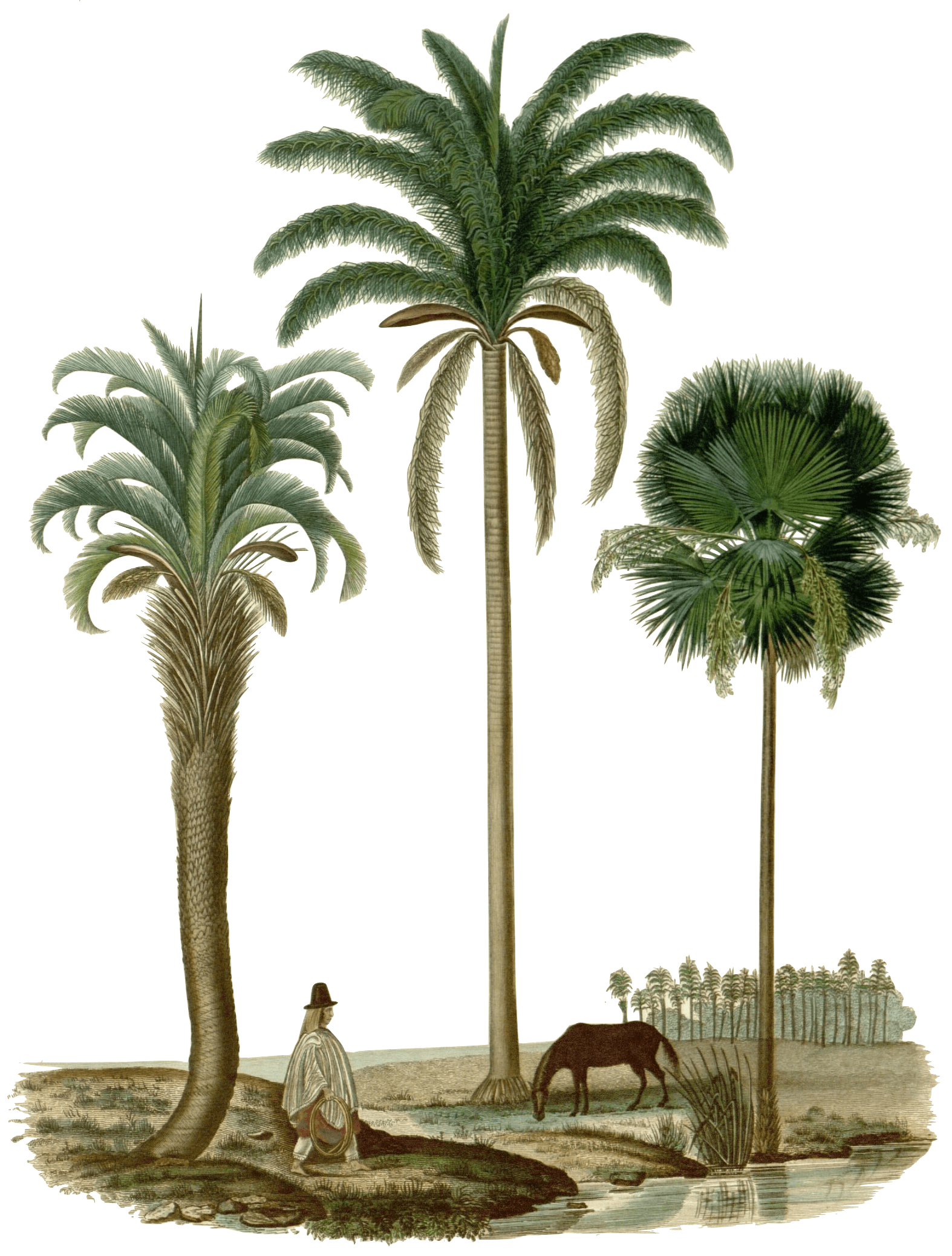
Palm
The fan-like leaves of palm trees shake, clatter, then settle after a rousing gust of wind. Their strong, bare trunks sway, almost imperceptibly, over the water-logged paddies where rice is beginning to green the muddy surface. Wherever we find ourselves—on a tropical beach at dawn or in a temperate city at night—palms accompany us. They are the sweet, sticky dates eaten after long fasts in many parts of the world and the spoonfuls of thick oil lending a rich taste to a variety of foods. They are the worn rattan chairs that creak as families meet around dinner tables. That the word palm also refers anatomically to a part of the hand suggests the tactile connection between the tree and humanity. What's more, especially for residents of cold climates, palms symbolize fertility, serenity, and escape from winter doldrums. Bending themselves to the elements, the trees embody gracefulness, adaptability, and resilience. It was the poet Rabindranath Tagore who, after observing a palm tree battered by a storm, wrote,
the fronds subside, subside
the mind of the tree returns
To earth, recalls that earth is its mother.1
The mind of the tree returns. Recalls that earth is its mother. As a minded being, Tagore's tousled tree feels love and remembers. These reflections on the palm illustrate, for us, the process of becoming plant-minded—of attending to plants as they reciprocally attend to us, in the symbiotic dance that sustains the Earth and all life. Through expressions of care, curiosity, and openness, we can become entrained to the clanging fronds, the lithe trunk, the ripening fruit, and the vibrant human-plant networks of which they are part. Guided by these ideas, The Mind of Plants presents a lively convocation of plants, people, and places that, as editors, we hope will inspire fresh ways of seeing—of feeling and of being with—the photosynthetic personae with whom we share this precious, imperilled planet. Our anthology takes as its starting point current research in fields such as plant signalling and behavior that calls attention to the capacity of vegetal life to discern between options, learn from prior experiences, and negotiate traumatic memories to minimize adverse effects on future generations—or, in other words, to think.2
The current, burgeoning, popular, and scholarly interest in the plant mind enjoys a venerable lineage. As our contributors reveal, the idea that plants have a mind of their own has been a core element of Indigenous stories, literary works, poetic imaginings, philosophical systems, and experimental investigations from around the world.3 For instance, among the Aboriginal people of Southwest Australia, during the creation of the world, enormous ancestral beings raised the sky to its spiralling height with the generous help of old-growth gum trees called karris. In this spirit, The Mind of Plants gathers lyrical, reflective, experiential, and oftentimes deeply personal evocations of plant minds and their connection to humans, the mind understood here as an embodied and embedded form of being. Our aim with this anthology is to reflect upon the ways that humans mind and unmind plants, as well as on the mindedness or unmindedness of plants themselves as percipient personae. Our essayists, poets, and artists address this topic through a synergetic blend of contributions that include narratives of plants as cultural, ecological, historical, literary, social, and spiritual forces; of plants as agents of memory and emotion.
Encouraging textured, multi-hued responses to the theme, we asked each contributor to select a plant as a focal point for reflection. By foregrounding the common name as a guiding thread, The Mind of Plants emphasizes the active role plants played in the creation of this book. For, while our essayists, poets, and artists chose their plants, they are aware of the fact that, to a large extent, it was the plants who chose them. As editors, we see this anthology as the outcome of a collaboration between the contributors and the plants themselves. Our view of the unscripted, synchronistic process informing the collection accords with emerging understandings of plants as participants in the creative process, rather than simply as the passive materials out of which our cultural productions arise.4
Moving away from a hierarchical organization of plants and taxonomic information associated with them, the anthology playfully evokes, connects with, and advances the long tradition of botanical texts. The arrangement of essays and poems alphabetically by vernacular names is reminiscent of old herbaria, all the while moving away from their classificatory focus. Our intention was to pay tribute to this immense body of knowledge, while subverting its largely reductionist approach to botanical life. Avoiding a simplistic dissection of vegetal forms of existence, in which humans are authority figures who coldly observe, describe, and define plants as inert objects, The Mind of Plants stages a dialogue between diverse plants, people, and places.
Composed of interactions, exchanges, and other filamentous strands, The Mind of Plants cuts across not only different species and scientific kingdoms, but also across various—human and more-than-human—cultures. This hands-on, pragmatic approach to plant life is the reason why we chose to include living beings such as algae, who are not stricto sensu plants from a scientific point of view. Aiming to be as inclusive as possible, we wished to produce a compendium documenting plants' everyday dealings with humans, unfettered by academic and scientific jargon. The result is a confederation of vegetal and human life that, although marked by sometimes violent historical developments—colonialism, neo-colonialism, totalitarianism, plantation economies, and neo-liberal monoculture agribusinesses, mentioned in many of our chapters—testifies, in the synchronicity of its coming-together, to the possibility of a more egalitarian connection between plants and people.
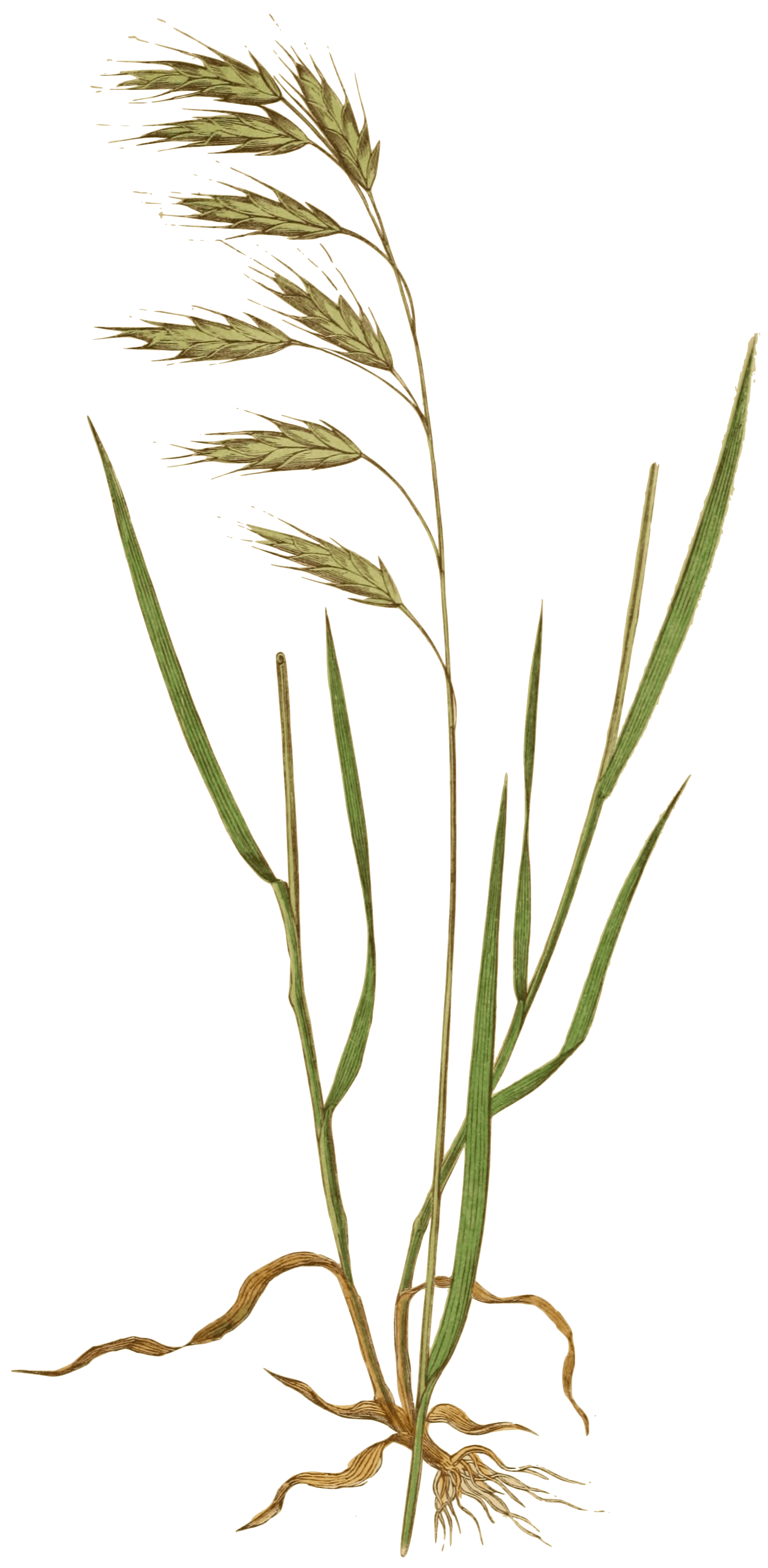
Grass
Looking out of the window on a cold, dreary, winter morning; taking your dog out for a walk around the neighbourhood in the late afternoon, after a long day's work sitting at the desk; or enjoying a well-deserved weekend hike at the nearest park, you are bound to see it. Grass is all around us, adorning well-manicured suburban lawns, sprouting in the crevices of city sidewalks and covering the soil of vast, wild expanses of forest and prairie. It is so ubiquitous we barely notice it. We usually only pay attention to it when it oversteps its boundaries, when it grows too tall or invades spaces reserved for other plants and for human-made structures. We then begrudgingly mow, cut, and deracinate it, only to firmly put it out of mind until it once again defies human-defined rules and we are called upon to discipline it anew.
But the grass we mostly disregard has its own stories to tell, many of which are entwined with the existence of humans. Does it like to live in our gardens, to be watered and fertilized, while also mowed and trimmed to fit our aesthetic and leisure needs? Or would it prefer to take its chances in the wild, at the mercy of droughts and plagues, but free to grow as tall, far, and wide as it can? Who are grass's vegetal and animal allies and foes? And who or what are we even referring to when we talk about grass? Do we mean the entire grass patch, a group of leaves, or a single blade?
The omnipresence of the being we call "grass" is but a simple reminder of the centrality of plants in human everyday existence. From the air we breathe, through the food we eat, to our clothes, housing, and even arts, plants determine all aspects of human lives. The Mind of Plants calls upon you, our reader, to bracket your routine, automatic behavior toward plants and to see them as more than sources of oxygen, nourishment, and raw materials. They are all that, of course, but what else? The essays, poems, and artworks in this collection dwell on the specificities of plant life in all of its bewildering variety and on the multiple interactions between plants and humans. Drawing on Walt Whitman's renowned metaphor, each contribution is like blade of grass, an instantiation of the complex ties human beings establish with plants that determine their research interests, their work, and their lives in myriad different ways.
This anthology conjures up the lived experiences of vegetal and human beings, recollections such as those of playing on a grass meadow, of closely monitoring the vibrant insect life that thrives among tiny blades of grass, or of lying down in the shade on a cool grass patch to read a book during a hot summer day. Akin to grass, the anthology grew organically in directions determined by the various contributors. With no predefined list of plants to be included, the process of putting together the volume was decentralized, with no main core, as the creation of texts followed a plant logic, sprouting grass-like wherever it found fertile ground. This horizontal structure is the reason why some plants that have played a key role in human culture are missing from this anthology—poppy, potato, tobacco, among many others, are cases in point. But, while you will inevitably miss some plants absent from the book, you will certainly meet new ones, or deepen your appreciation of plants you encounter on a daily basis, such as grass, about whom you may not often pause to think.
A field of grass, or a groomed garden lawn, is an open ground of possibilities. Devoid of a clear, one-way track, it invites one to wander through it, to stroll leisurely in different directions, simply enjoying the walk. Similarly, you, as the reader, can devise multiple pathways into The Mind of Plants. You could, for instance, start with the plants you know best, and then slowly radiate out into less familiar ones, just as one meets new friends through their connections with older ones. Or you can take the opposite approach and start with plants you have never seen in the wild, staging a literary encounter with a vegetal being that you are unacquainted with in the flesh, in the same way as we now intimately get to know each other digitally and remotely, oftentimes even better than when we shook hands every day.
Another avenue for exploration is to concentrate on certain types of plants—bushes, shrubs, trees, epiphytes, etc.—or on their connections to and effects upon humans: stimulants such as coffee or tea; edible plants like apple, bean, corn, spinach, or wheat; ornamental plants, including birdflower or rose; mind-altering plants such as ayahuasca, cannabis, peyote, or yopo, and so on. If you are a more lyrically-inclined reader, you can also begin by approaching plants through poetry, while others might decide to engage first with the essays that draw connections between vegetal beings and the arts. Purposefully open-ended, this anthology invites each one of you to root yourself in your choice of texts or to allow yourself to be surprised and interpellated by this collection of plants, only to let your relationship to vegetal life branch out with new shoots and leaves, flowers, and then bear fruit.
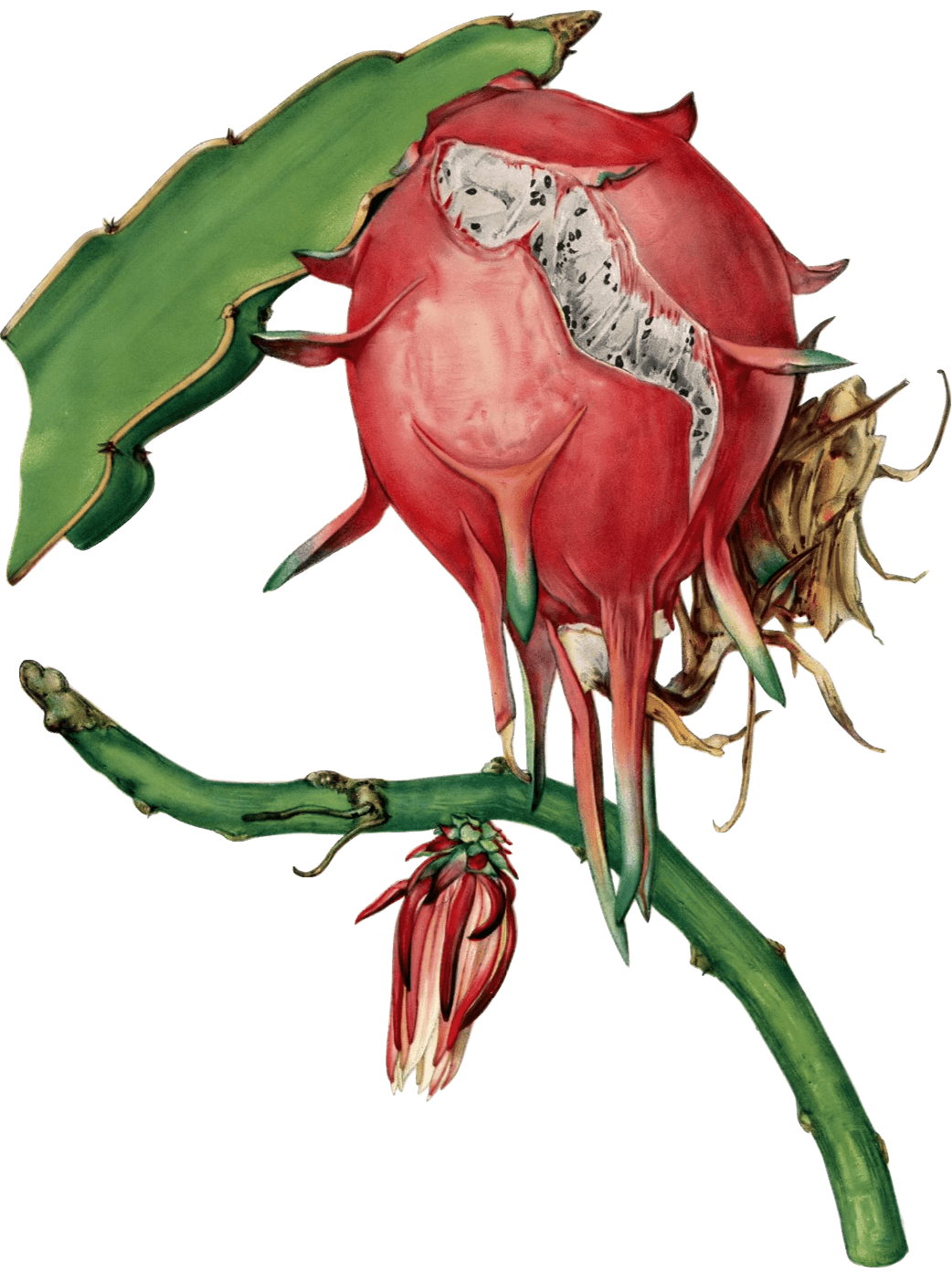
Cactus
A night-blooming cactus vine gleams in the cool tropical morning. Drenching rainfall flumes rhythmically down its thick, ribbed stems. Ripening and reddening, day by day, deeper into the monsoon season, its leathery fruit is growing flush with betacyanin, the nourishing pigment underlying its magenta radiance. Known in Spanish as pitahaya, dragon fruit (Hylocereus costaricensis) is botanically an epiphyte, a plant living in a state of relative balance on another plant, often a tree, though without resorting to parasitism. From the heart-like fruit, beating with sweet antioxidants, the vine traces a circuitous path through frangipani branches, then around the pendulous fronds of a fellow epiphyte, a staghorn fern. The charismatic, though retiring, guardian of this Balinese home, pitahaya welcomes the doused dawn.
Yet, before the cactus became visually discernible within its tangled mass of green in the middle of the traditional courtyard, the fruit had announced itself to the tongue and taste buds. There were plump slices on plates, frothy purplish juice in glasses, and tiny black seeds pestled between teeth. An interlocutor—one who engages in dialogue with another—dragon fruit was also an intellectual presence. Before it became a body before us, the plant was a cluster of ideas, constellation of names, corpus of knowledge, and mode of being that humans attempt, but often fail, to communicate to one another through the pains of language. As our elegantly dressed local host pointed to something behind us and announced proudly, "there's my dragon fruit tree," our heads pivoted out of reflex to notice, for the first time, the vivacious vegetal dwelling beside us. In that moment, we experienced a strong sensation of sudden encounter—of serendipitously meeting the plant universe and, namely, the dragon fruit, halfway.5 In the same manner, The Mind of Plants brims with stories of meeting and being met, seeing and being seen, feeling and being felt.
Central to the anthology is the tradition of the herbarium, defined as a collection of preserved plant materials and data, including precise anatomical descriptions, all organized systematically to enhance botanical knowledge. In the development of Western botany, herbarium specimens have been vital reference points for identifying species, assigning technical names, and elucidating taxonomic relationships. Demonstrating the close historical connection between botany and medicine, herbals of the Middle Ages detailed the medicinal virtues of plants and documented the rich knowledge of flora common to people during this period. Early herbaria, such as Gherardo Cibo's from the sixteenth century, evolved to house pressed specimens, or hortus siccus, mounted on sheets for ease of access. As botanists began to exclude information about virtues from their narratives, herbals transformed into floras, or technical descriptions companionable with the function of the herbarium as a classificatory tool. This transition from herbals to floras indeed reflected the increasing split between the disciplines of medicine and botany.
At the same time, this movement away from herbals resulted in an affective divide between plants and people. From being focused on medicine, healing, and nutrition—and specifically engaging the senses of taste, smell, and touch—traditional botanical knowledge systems became increasingly relegated to the domain of the abstract. By its very nature, a herbarium specimen adheres to a logic of reduction. The anatomical part—seed, fruit, flower—is extracted from the plant body while the whole plant, in turn, is removed from its web of ecological relations. Take, for instance, a night- blooming cactus specimen pressed in 1974 and stored at the Division of Plant Industry Herbarium in Florida. The creamy white flowers typical of the cactus have browned, revealing an orderly array of stiff, soldierly anthers. Defying the two-dimensional logic of the herbarium, the succulent fruit and spiny stems are absent. Yet also missing are the sensuous narratives of human interaction with the cactus—stories of eating fruits and dispersing seeds. As a cultural herbarium of vegetal beings, The Mind of Plants opens up a space for those stories to emerge and re-emerge, along with the many knowledge systems they represent.
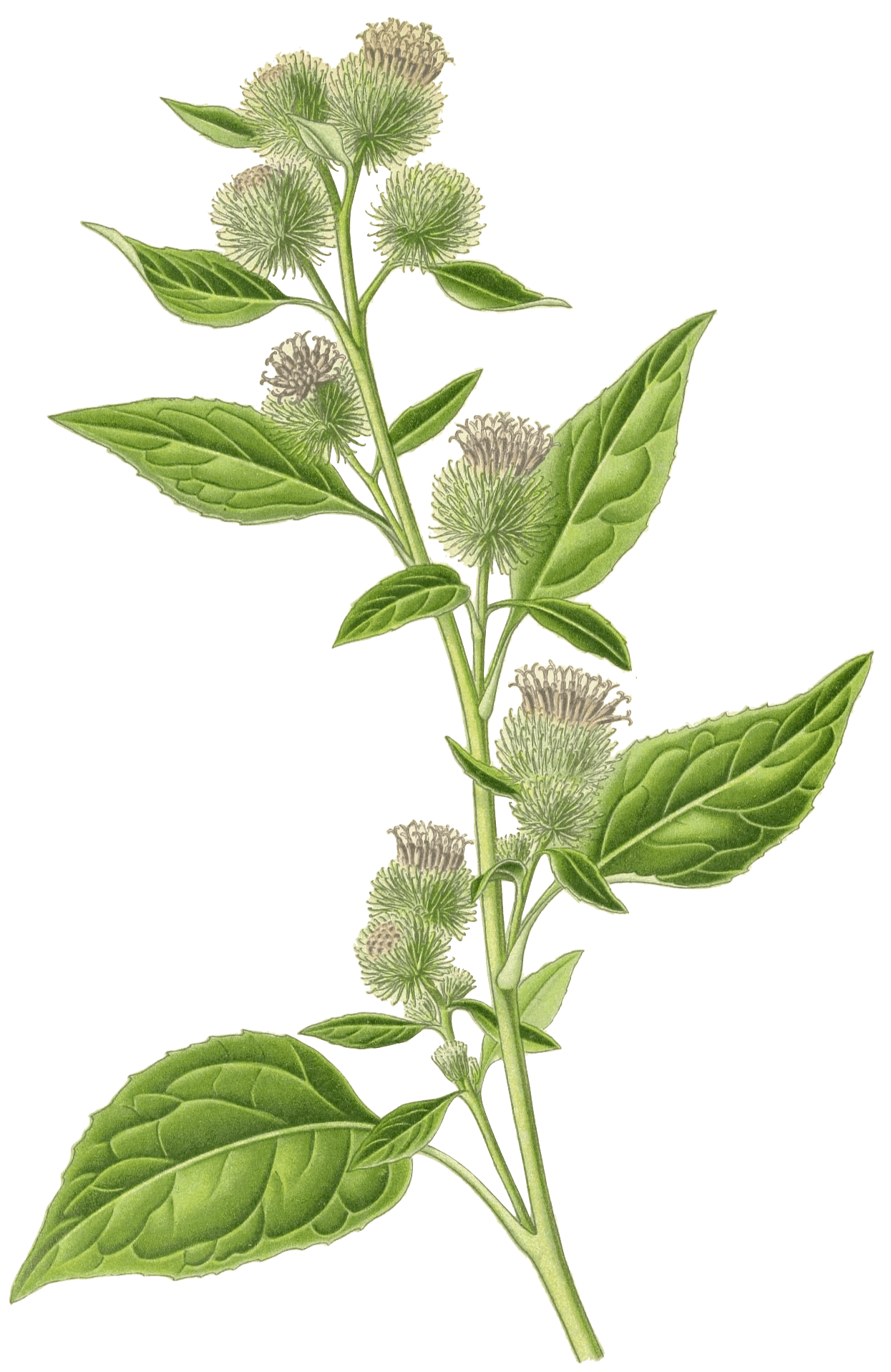
Burdock
In almost every corner of the world, especially if you're lost in an abandoned field or wandering along a backwoods track, you're likely to encounter greater burdock (Arctium lappa). The name of this eminently clingy character conjures the infamous burr, a hooked seed impeccably adapted for hitching rides on mobile creatures, including those of us who stray off course. Growing to monstrous proportions in biennial cycles, the plant can reach heights of ten feet, with leaves the size of a human torso and a bulky tap root descending three feet or more into the earth. Burdock is, literally, an irritating plant, though not without good reason. The silky pappus hairs of its fruits fasten readily to the skin, hair, eyebrows, and other sensitive areas, triggering inflammation and allergic episodes in those unfortunate enough to come into contact with it. What's more, the barbed bracts enclosing its delicate purple flowers attach easily to the fur of mammals—and likewise the sweaters of Homo sapiens—enabling seeds to spread into new areas at considerable distances.
Perfecting crafty tactics of vegetal mobility, burdock has become a notorious and ubiquitous invader—a master of agitating us while, simultaneously, recruiting us to do its bidding. Nonetheless, the irksome qualities of burdock belie its giving nature. In fact, its medicinal, nutritional, ecological, and economic attributes are too plentiful to list here but centre, to a large extent, on its fleshy tap root. Considered a purifying agent in many herbal systems, burdock root has been shown to promote circulation, remove bloodstream toxins, interrupt cancerous growth, improve skin problems, and reduce inflammation. Sometimes pickled, the root has been an essential ingredient of diverse culinary traditions and is especially valued in Japanese cuisine. Also of note is the fact that burdock supplied the organic template for George de Mestral's development of the touch fastener, otherwise known as Velcro, a common find in many pieces of clothing, shoes, and kitchen cabinets today.
Valuable insights arise from being bothered by plants like burdock. In becoming perturbed, in being thrown out of our familiar terrains of comfort, we can open to plant voice—that speechless, strange, yet persuasive way vegetal life summons us. Botanical wisdom doesn't always come wrapped up in stunning blossoms or luscious fruits. Lessons are at times laced with barbs and burrs. As it latches to our clothing, this is what burdock tells us. As they inflame and sting our skin, this is what poison ivy and common nettle say too. As it overtakes our nasal passages and nauseates our stomachs, this is the message of durian—a fruit highly esteemed by some, seriously detested by others, and so pungent that it has been banned by certain Southeast Asian hotels. From cannabis and coffee to the suicide tree and xiang si, The Mind of Plants is as much about what plants think and what plants think of us, as it is about the bodily connections between human, vegetal, and other forms of life. Plants provoke and disturb us, humans, at the same time as they nourish our bodies and thoughts. As mind-expanding ayahuasca, cannabis, and peyote teach us, the lessons of the botanical world often register in the body before they alight in the mind.
Burdock's complex character also illumines for us the idea of emplacement. Research has shown that intelligence in plants and, arguably, all life, is intimately linked to place.6 In the case of barbed burdock, being sessile is not a disadvantage but has enabled the plant to develop canny techniques for getting around. Certainly, plants are embedded in given places, but they also possess powers of dispersion that we don't yet fully comprehend. It is the oscillation between rootedness and uprootedness that characterizes plant being. That a species like burdock has successfully disseminated itself around the globe testifies to the percipient mobilities evolved by plants. The ideas of place and emplacement also speak to our own situations as editors, dispersed across three continents, embedded in very different ecologies, occasionally unable to communicate because of wildfires and the coronavirus, yet balancing rootedness and uprootedness through a shared filiation with flora and the impassioned plant-people who have made this book possible.
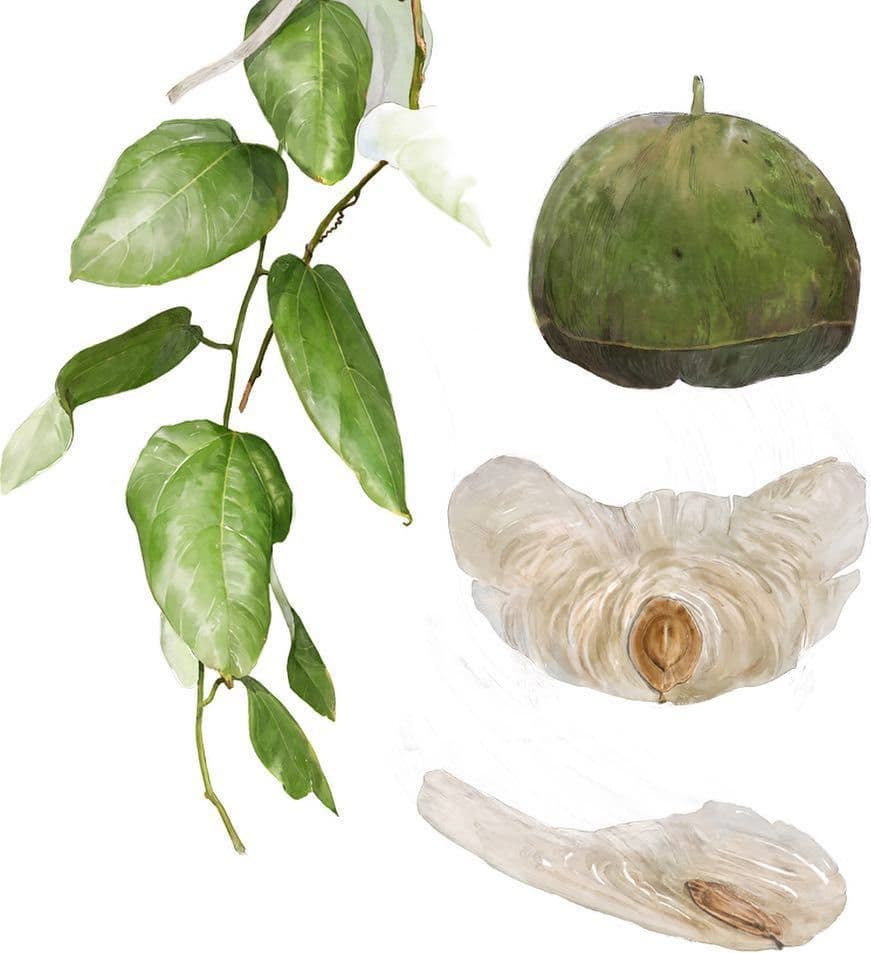
Liana
Gliding around like delicate butterflies or pirouetting through the air like elegant ballerinas, samara seeds fly with aerodynamic precision to sow their winged bodies afar in a suitable place in the landscape. The champion of long-distance gliding is the large samara of the Java cucumber, Alsomitra macrocarpa—a tropical liana whose ultralight winged seeds stall, dip, accelerate, and then lift and gain altitude again, then finally and almost reluctantly land on the earth. There is great magic in the gliding of these samaras! Over a century ago, their spellbinding flight impressed a wish on the runaways; landing in a field beyond abstractions, the idea that took root inspired us to transcend our flightless human condition and, quite literally, soar.7
The practice of moving ideas around by observing the strategies used by other species, and particularly plants, mimicking and, in some way, recasting them in novel directions, dates back to 4000 BC (when the Chinese first learned about silk from the silkworm) but likely is as old as our human history. It is often understood that this information transfer depends on what we perceive as salient in our observations of the other. This "mining" of creative ideas from other species frames the other—any non-human other—as a discrete object out-there that we can observe from a separate and detached point of view. From this perspective, this objectified other has no subjective life, no passion or desire, no mind, no story to tell. And it is a static generality that exists exclusively as a fabrication of a modern, dominant scientific paradigm that separates the human from the rest of life. Aside from the fact that this rupture is internally incongruent with the core Darwinian understanding of the interconnectedness of life forms that underpins the modern scientific paradigm itself, there simply is no objectified other in the world we all live in—an entangled world of subjectivities, continuities, and we-ness.
As in the samara, in the pages of this book you will encounter seeds of ecological fluency. Over and over again, through the collaboration between time and space, these seeds soared in the prose of our best poets and essayists who praised the grandeur8 that endlessly flows around and through all life forms. Time and again, these seeds revealed stories of continuities in the material origin across life, while wishing, in a mischievous game of hide-and-seek, to conceal such unity through the mutability and transmutation of bodily form. But, like the Alsomitra samara with its paper-thin diaphanous wings, these seeds carry the realization that we are all composites of subjectivities, permanently in the making within the physical, emotional, and spiritual ecologies we co-inhabit with others. It is the openness (or closed-ness) of our bodies to other forms of life that moulds the texture of our own lives, the stories we tell and the stories we hear.9
In these pages, plants take the lead in materializing these stories within the relational body of reciprocity and proximity with human co-authors. Through a dynamic process of co-narration, these stories are seeds of inescapable intimacy—personal narratives grounded in the potential to speak directly to the human sense of wonder and our collective capacity for imagining possibilities that unveil the deep mysteries of existence, those basic realities less travelled. Their final destination may lie far outside the accepted limits of our dominant paradigm, but their exquisite design, like that of the Alsomitra samaras, promises to take us far in our collective journey to a deeper appreciation of, and a devotion to, plants and life itself.
Our hope as editors is that the texts in The Mind of Plants travel far and wide. Delivered to the world, the essays, poems, and artworks in this anthology will, akin to samara seeds, disseminate and undertake their own journeys into your libraries and your minds. With no fixed destination, the anthology will contribute to our understanding of what goes on in a plant's mind and to our human mindedness of all the vegetal beings with whom we share our existence.
Footnotes
-
Rabindranath Tagore, "The Palm Tree," Poem Hunter. ↩
-
Monica Gagliano, "The Mind of Plants: Thinking the Unthinkable," Communicative and Integrative Biology, e1288333 (2017). ↩
-
Mary Siisip Geniusz, Wendy Makoons Geniusz, and Annmarie Geniusz, Plants Have So Much to Give Us, All We Have to Do Is Ask: Anishinaabe Botanical Teachings (Minneapolis, MN: University of Minnesota Press, 2015). ↩
-
John C. Ryan, "Writing the Lives of Plants: Phytography and the Botanical Imagination," a/b: Auto/Biography Studies 25, no.1(2020): 97–122. ↩
-
The expression "meeting the plant universe halfway" is adapted from Karen Barad's Meeting the Universe Halfway: Quantum Physics and the Entanglement of Matter and Meaning (Durham, NC: Duke University Press, 2007). ↩
-
Tony Trewavas, "Plant Intelligence: An Overview," BioScience 66, no. 7 (2016): 542–551. ↩
-
Akira Azuma and Yoshinori Okuno, "Flight of a Samara, Alsomitra macrocarpa," Journal of Theoretical Biology, 129 (1987): 263-74; and Julian Vincent, et al, "Biomimetics: Its Practice and Theory," Journal of the Royal Society Interface, 3(2006): 471–482. ↩
-
This is a reference to Charles Darwin who famously ended his seminal book On the Origin of Species (London, UK: John Murray, 1859) with an extremely poetic paragraph—the "entangled bank"—on the variety of life forms and the rich complexity of interactions between them, and the conclusion,"There is grandeur in this view of life." ↩
-
Megan Craig, "Narrative Threads: Philosophy as Storytelling," The Journal of Speculative Philosophy, 28, no. 4 (2014): 438–453. ↩
